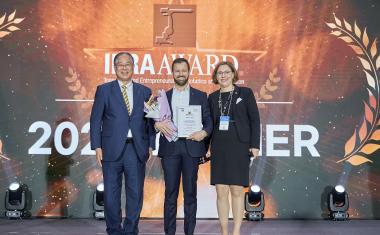Improving long distance quantum communication
Dual band stabilisation technique cancels the problem of temperature and strain fluctuations.
The Cambridge Research Laboratory of Toshiba Europe announced recently the first demonstration of quantum communications over optical fibers exceeding 600 kilometers in length. The breakthrough will enable long distance quantum-secured information transfer between metropolitan areas and is a major advance towards building the future Quantum Internet. This future global network of quantum computers will be connected by long distance quantum communication links. It is expected to allow the ultrafast solution of complex optimization problems in the cloud, a more accurate global timing system and highly secure communications across the globe. Several large government initiatives to build a quantum internet have been announced, for example in the US, EU and China.

One of the most difficult technological challenges in building the quantum internet, is the problem of how to transmit quantum bits over long optical fibres. Small changes in the ambient conditions, such as temperature fluctuations, cause the fibres to expand and contract, thereby scrambling the fragile qubits, which are encoded as a phase delay of a weak optical pulse in the fiber. Now, Toshiba has demonstrated record distances for quantum communications by introducing a novel dual band stabilization technique. This sends two optical reference signals, at different wavelengths, for minimizing the phase fluctuations on long fibres. The first wavelength is used to cancel the rapidly varying fluctuations, while the second wavelength, at the same wavelength as the optical qubits, is used for fine adjustment of the phase. After deploying these new techniques, Toshiba found it is possible to hold the optical phase of a quantum signal constant to within a fraction of a wavelength, with a precision of 10s of nanometers, even after propagation through 100s of kilometers of fiber. Without cancelling these fluctuations in real time, the fibre would expand and contract with temperature changes, scrambling the quantum information.
The first application for dual band stabilization will be for long distance Quantum Key Distribution (QKD). Commercial QKD systems are limited to around 100-200 kilometers of fiber. In 2018, Toshiba proposed the Twin Field QKD protocol as a way to extend the distance, and tested its resilience to optical loss using short fibres and attenuators. By introducing the dual band stabilization technique, Toshiba has now implemented Twin Field QKD on long fibers and demonstrated QKD over 600 kilometers, for the first time. “This is a very exciting result,” says Mirko Pittaluga. “With the new techniques we have developed, further extensions of the communication distance for QKD are still possible and our solutions can also be applied to other quantum communications protocols and applications”.
Andrew Shields, Head of the Quantum Technology Division at Toshiba Europe remarks, “QKD has been used to secure metropolitan area networks in recent years. This latest advance extends the maximum span of a quantum link, so that it is possible to connect cities across countries and continents, without using trusted intermediate nodes. Implemented along with Satellite QKD, it will allow us to build a global network for quantum secured communications.” Taro Shimada, Corporate Senior Vice President and Chief Digital Officer of Toshiba Corporation reflects, “With this success in Quantum Technology, Toshiba is willing to further expand its quantum business with rapid speed. Our vision is a platform for quantum information technology services, which will not only enable secure communication on a global scale, but also transformational technologies such as cloud-based quantum computing and distributed quantum sensing.”
The work was partially funded by the EU through the H2020 project, OpenQKD. The team is now engineering the proposed solutions to simplify their future adoption and deployment. This latest development follows the announcement last year that BT and Toshiba had installed the UK's first industrial quantum-secure network. Transmitting data between the National Composites Centre (NCC) and the Centre for Modelling & Simulation (CFMS), Toshiba's multiplexing compatibility allows the data and the quantum keys to be transmitted on the same fibre, eliminating the need for costly dedicated infrastructure for key distribution. The combined arrival of multiplexed QKD using existing infrastructure for shorter distances, alongside Twin Field QKD for longer distances, paves the way for a commercially viable global quantum-secure network.
QKD allows users to securely exchange confidential information over an untrusted communication channel. It does that by distributing to the intended users a common secret key that can be used to encrypt, and thus protect, the information exchanged over the communication channel. The security of the secret key rests upon the fundamental properties of individual quantum systems which are encoded and transmitted for the key generation. In the event that these photons are intercepted by an undesignated user, quantum physics guarantees that the intended users can perceive the eavesdropping, and consequently protect the communication.
Unlike other existing security solutions, the security of quantum cryptography derives directly from the laws of physics we use to describe the world around us, and for this reason, it is secure against any future advances in mathematics and computing including the advent of quantum computers. In light of this, QKD is expected to become an essential tool for protecting operation-critical communications for businesses and governments. (Source: Toshiba)
Link: Quantum Information Group, Cambridge Research Lab, Toshiba Europe Ltd, Cambridge, UK











